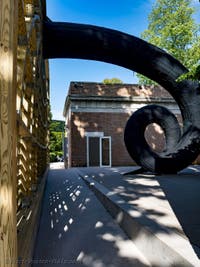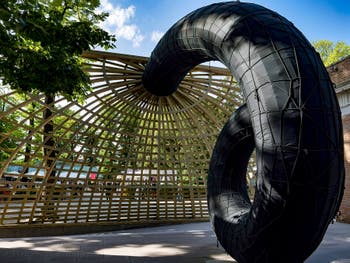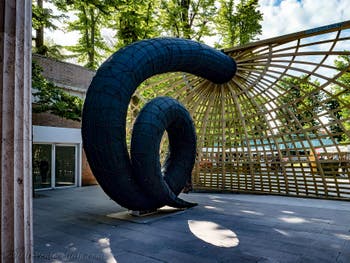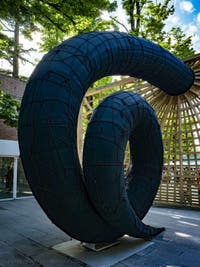Biennale Biennale Art | Architecture
Biennale Art 2024 | 2022 | 2019 | 2017
Artists Armitage | Bove | Bendayan | Bertlmann | Canosa | Chiha/Karim/Abdallah | Condo | Da Corte | David | Gruyter/Thys | Hamilton | Hernandez | Ihrman | Jamie | Jarpa | Jungerman | Kensmil | Kolíbal | Liu Wei | Marclay | Mehretu | Minoliti | Moulene | Muholi | Mulleady | Ozbolt | Pieski | Prouvost | Puryear | Shishkin | Singer | Sokurov | Stanczak | Taylor | Upson | Ursuta | Wagner/Burca | Wilkes| Yi A. | Yoon
Martin Puryear Venice Biennale International Art Exhibition
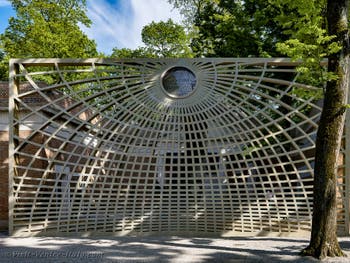
Puryear, Swallowed Sun Martin Puryear is an African-American sculptor, born May 23 1941, in Washington.
His sculptures with subtle, symbolic and powerful shapes are mostly made of assembled pieces of wood.
Stunning works were presented during this 2019 Venice Art Biennale at the United States Pavilion at the Giardini.
Martin Puryear “Swallowed Sun” (Monstrance and Volute)
Sculpture - Wood, Rope, Metal, Polyester (6.9 x 13.4 x 7.4 meters) 2019 Venice Art Biennale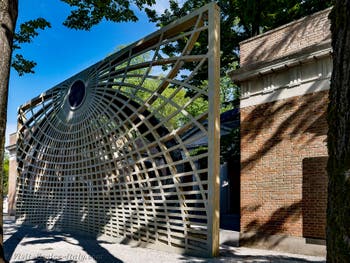
Puryear, Swallowed Sun This imposing work is located at the pavilion entrance and is entitled "Swallowed Sun.
A beautiful and huge solar grid made of southern yellow pine represents the sun’s rays that cross the sky.
At the top of the solar radiation is a circular opening behind which the mouth of a half-snake, half-larva monster sticks.
This tubular monster, a kind of colossal larva worm rolled upon itself, swallows sunlight through the opening of the solar grid.
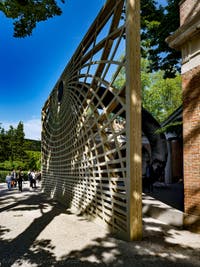
Puryear, Swallowed Sun A monster in whose stomach light becomes darkness, where freedom, the theme of the American Pavilion exhibition this year, disappears.
This frightening being swallows up the light is quoted in the Ancient Egyptians’ Book of the Dead.
It represents Apophis, the dragon of the Abyss and Darkness, the embodiment of Absolute Evil, the worst enemy of Ra, the sun god.
Fortunately, Ra wins the cosmic duel between Light and Darkness.
This Dark Dragon, imagined by the ancients and Martin Puryear’s tubular monster, perfectly illustrates the famous "black holes" recently revealed by telescopes.
Martin Puryear “Cloister-Redoubt or Closed-Down Doubt?”
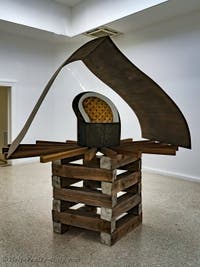
Puryear Cloister-Redoubt Sculpture - American hemlock, Eastern White Pine, Tulip Poplar, Red Cedar (253 x 244 x 136 cm) 2019 Biennale Art Venice
This sculpture “Cloister-Redoubt or Closed-Doubt?” represents a refuge inaccessible to reason, according to Martin Puryear.
A sculpture made from various woods: American hemlock, eastern white pine, tulip poplar and red cedar.
Their assembly is intended to create a protected and, at the same time, inaccessible space, an image of individual interiority that is like a temple separated from the secular world.
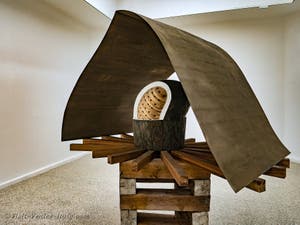
Puryear Cloister-Redoubt Here Puryear contrasts natural shapes, flexible and shapely, alive, with others, more gathered, tight, dense.
According to Martin Puryear, this sculpture mediates the mystery of religious belief and represents faith as an elaborate construction.
This work evokes at the same time a sanctuary, protection, confinement and reclusion.
Martin Puryear “Hybernian Testosterone”
Sculpture - Painted Aluminum, American Cypress (145 x 358 x 113cm) 2018 Venice Art Biennale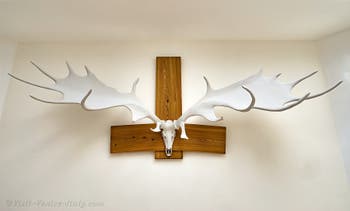
Martin Puryear, Hybernian Testosterone It is not just any horned animal that Martin Puryear represents in this sculpture, but precisely the great Irish elk, a species now extinct.
The antlers of this elk were particularly disproportionate to the rest of its body.
Antlers whose wingspan could reach four meters, which essentially served him to fight his rivals and parade in front of the females to seduce.

Martin Puryear, Hybernian Testosterone According to palaeontologists, the explanation of the existence of deer and elk with antlers so developed in the prehistoric era is linked to the high level of testosterone produced by these animals.
The extinction of this species and its representation by Puryear symbolize the loss of meaning of male physical power.
But he does not lack humour by showing clearly the disproportion of the horns compared to the skull of the super male: his sexual power and physical strength were oh so much more developed than his brain...
Artists Armitage | Bove | Bendayan | Bertlmann | Canosa | Chiha/Karim/Abdallah | Condo | Da Corte | David | Gruyter/Thys | Hamilton | Hernandez | Ihrman | Jamie | Jarpa | Jungerman | Kensmil | Kolíbal | Liu Wei | Marclay | Mehretu | Minoliti | Moulene | Muholi | Mulleady | Ozbolt | Pieski | Prouvost | Puryear | Shishkin | Singer | Sokurov | Stanczak | Taylor | Upson | Ursuta | Wagner/Burca | Wilkes| Yi A. | Yoon
Biennale Art 2024 | 2022 | 2019 | 2017
Biennale Biennale Art | Architecture
Back to Top of Page


